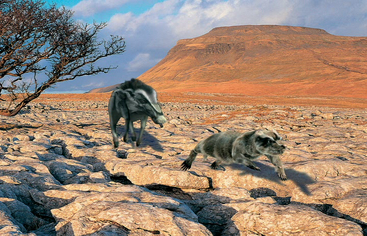
The scrofa is a species of small, delicate-looking suine suid, descended from the wild boar(Sus scrofa) that lives on the rocky karst of the Mediterranean Basin of 5 million AD in the documentary The Future is Wild. It is one of the animals that has appropriately adapted to live in this new landscape.
In the shelter of the grykes, mother cryptiles hide their eggs. They will be safer here than on the open salt plains, but there are dangers nonetheless. Snuggling about in the broad passageways of the grykes is the scrofa, a descendant of the wild boars that once ranged across much of Eurasia, North Africa and the Greater Sunda Islands in the Quaternary. Wild boars were hardy creatures, adaptable to changing conditions and generalized in their feeding habits. They fed largely on grain and roots, but occasionally would kill and eat smaller animals.
In 5 million AD, scrofas are similar in many ways to their ancestors, although they are more slender and only about half as tall. They are about 14.75 inches (37.5 centimeters) high at the shoulder and weigh 8.25 pounds (3.75 kilograms). Delicate hooves and agile limbs allow them to prance along the wide slabs of limestone pavement, known as clints, leaping over the grykes as they go. Walking over rugged limestone is very different from roaming through a forest. Scrofa legs have become thinner, and the bones elongated. They walk on the tips of their toes, giving them a strange, stiff-legged gait. This is an efficient way of moving over surfaces like the karst. This adaptation is similar to the klipspringer of previous times.
The generalized, omnivorous diet has not changed much either. Scrofas will eat almost anything. Plant material forms a large part of their diet, but they will also prey on slow-moving smaller animals and carrion. Their cylindrical noses, used for searching out food from the bottom of grykes, are longer than those of their wild boar ancestors, and are now short, flexible "trunks", similar to those of the elephant shrews or sengis of the Human era.
The long nose of a snuffling, foraging scrofa can find newly-laid reptile eggs (including that of cryptiles) in the shallow soil. Its tusks can loosen the eggs from their hiding place and its long lips can snap them up, then it moves on.
Scrofa herds spread out across the karst. There are two dominant females (the joint leaders of a herd). A scrofa herd is essentially a family group, consisting of the leaders and their offspring. The only males in the group are juveniles. Once the males reach sexual maturity, they leave their herds to begin hunting and foraging on their own, mating with the dominant sows of other herds and fighting with other lone males for mating privileges.
In the late spring, scroflets are born in litters of between three and six. This is the beast time of year for raising young, as there is more food available in the bleak environment. Wherever scrofas go foraging, there are always two or three herd members on the lookout for danger. Birds of prey circle in the skies above the karst, but other dangers lurk in the grykes themselves.
Down by the edge of the salt flats, herds of scrofas are relatively safe - but there is little food to be found there. On slightly higher ground, soil particles blown into the grykes from the continental interior allow vegetation to grow. Patches of wispy grass sprout up from the flat surfaces of the clints. Hazel trees grow in bunches along the grykes, stunted and gnarled, their roots reaching down hundreds of feet to whatever water table exists here. This is the best feeding ground for scrofa herds at this time of year (spring), since vegetation is relatively abundant. Unfortunately, it is also the domain of the scrofas' greatest enemy: the gryken.

A female scrofa rescues her baby from a gryken.
Although grykens will not attack adult scrofas, they will hunt down any youngsters (scroflets) that wander away from their family herds.
On very rare occasions, a scroflet will probably become lost after either wandering away from the herd out of curiosity or from running from a predator attack. These lost scroflets will, on these very rare instances, wander out onto the salt flats and eventually die from hunger, thirst, and the heat.
|
|||||||||
